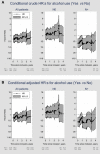Pre- and postoperative alcohol consumption in breast cancer patients: impact on early events
- PMID: 24892005
- PMCID: PMC4039662
- DOI: 10.1186/2193-1801-3-261
Pre- and postoperative alcohol consumption in breast cancer patients: impact on early events
Abstract
Purpose: To investigate the association between pre- and postoperative alcohol consumption and risk for early breast cancer events, since the association between alcohol consumption and prognosis in breast cancer patients is unclear.
Methods: Alcohol consumption was recorded for 934 primary breast cancer patients who underwent breast cancer surgery in Lund, Sweden, between 2002 and 2011 and were followed until December 31(st) 2012. Clinical data were obtained from medical records and population registries. Pre- and postoperative alcohol consumption was analyzed in relation to risk for early events.
Results: Median follow-up time was 3.03 years and 100 breast cancer events, 65 distant metastases, and 76 deaths occurred. Compared to no consumption, any preoperative alcohol consumption was weakly associated with lower risk for early events, adjusted HR 0.69 (0.45-1.04), distant metastases, 0.60 (0.36-1.00) and death, 0.62 (0.38-1.01). In the 572 patients without axillary lymph node involvement, any alcohol consumption was not associated with risk for early events. However, in the 360 patients with axillary lymph node involvement, preoperative alcohol consumption was associated with lower risk for early events (adjusted HR 0.43 0.24-0.77; P interaction = 0.01).
Conclusion: Pre- and postoperative alcohol consumption was weakly associated with lower risk for early breast cancer events. The data does not support recommending that all breast cancer patients abstain from low to moderate alcohol consumption.
Keywords: Alcohol consumption; Breast cancer; Death; Early breast cancer events; Early distant metastases.
Figures



Similar articles
-
Local recurrences and distant metastases after breast-conserving surgery and radiation therapy for early breast cancer.Int J Radiat Oncol Biol Phys. 1999 Jan 1;43(1):25-38. doi: 10.1016/s0360-3016(98)00365-4. Int J Radiat Oncol Biol Phys. 1999. PMID: 9989511
-
Axillary dissection versus no axillary dissection in patients with sentinel-node micrometastases (IBCSG 23-01): a phase 3 randomised controlled trial.Lancet Oncol. 2013 Apr;14(4):297-305. doi: 10.1016/S1470-2045(13)70035-4. Epub 2013 Mar 11. Lancet Oncol. 2013. PMID: 23491275 Free PMC article. Clinical Trial.
-
Predicting axillary sentinel node status in patients with primary breast cancer.Neoplasma. 2013;60(3):334-42. doi: 10.4149/neo_2013_045. Neoplasma. 2013. PMID: 23374005
-
Local recurrences and distant metastases after conservative breast cancer treatments: partly independent events.J Natl Cancer Inst. 1995 Jan 4;87(1):19-27. doi: 10.1093/jnci/87.1.19. J Natl Cancer Inst. 1995. PMID: 7666458
-
Correlation of tumor size and axillary lymph node involvement with prognosis in patients with T1 breast carcinoma.Cancer. 1998 Dec 15;83(12):2502-8. Cancer. 1998. PMID: 9874455 Review.
Cited by
-
Effects of Alcohol on Tumor Growth, Metastasis, Immune Response, and Host Survival.Alcohol Res. 2015;37(2):311-22. Alcohol Res. 2015. PMID: 26695753 Free PMC article. Review.
-
Alcohol consumption does not increase the risk of surgical wound complications in breast cancer patients.Int Wound J. 2020 Dec;17(6):1709-1716. doi: 10.1111/iwj.13455. Epub 2020 Jul 27. Int Wound J. 2020. PMID: 32715640 Free PMC article.
-
Prognostic Impact of Menopausal Hormone Therapy in Breast Cancer Differs According to Tumor Characteristics and Treatment.Front Oncol. 2020 Feb 6;10:80. doi: 10.3389/fonc.2020.00080. eCollection 2020. Front Oncol. 2020. PMID: 32117735 Free PMC article.
-
CYP27A1 expression is associated with risk of late lethal estrogen receptor-positive breast cancer in postmenopausal patients.Breast Cancer Res. 2020 Nov 11;22(1):123. doi: 10.1186/s13058-020-01347-x. Breast Cancer Res. 2020. PMID: 33176848 Free PMC article.
-
Potential interplay between tumor size and vitamin D receptor (VDR) polymorphisms in breast cancer prognosis: a prospective cohort study.Cancer Causes Control. 2024 Jun;35(6):907-919. doi: 10.1007/s10552-023-01845-1. Epub 2024 Feb 14. Cancer Causes Control. 2024. PMID: 38351438 Free PMC article.
References
-
- Ali AM, Schmidt MK, Bolla M, Wang Q, Gago-Dominguez M, Esteban Castelao J, Carracedo A, Munoz Garzon V, Bojesen SE, Nordestgaard BG, Flyger H, Chang-Claude J, Vrieling A, Rudolph A, Seibold P, Nevanlinna H, Muranen TA, Aaltonen K, Blomqvist C, Matsuo K, Ito H, Iwata H, Horio A, John EM, Sherman M, Lissowska J, Figueroa JD, Garcia-Closas M, Anton-Culver H, Shah M, et al. Cancer Epidemiol Biomarkers Prev. 2014. Alcohol Consumption and Survival after a Breast Cancer Diagnosis: A Literature-based Meta-analysis and Collaborative Analysis of Data for 29,239 Cases. - PMC - PubMed
-
- Allemani C, Berrino F, Krogh V, Sieri S, Pupa SM, Tagliabue E, Tagliabue G, Sant M. Do pre-diagnostic drinking habits influence breast cancer survival? Tumori. 2011;97(2):142–148. - PubMed
LinkOut - more resources
Full Text Sources
Other Literature Sources

